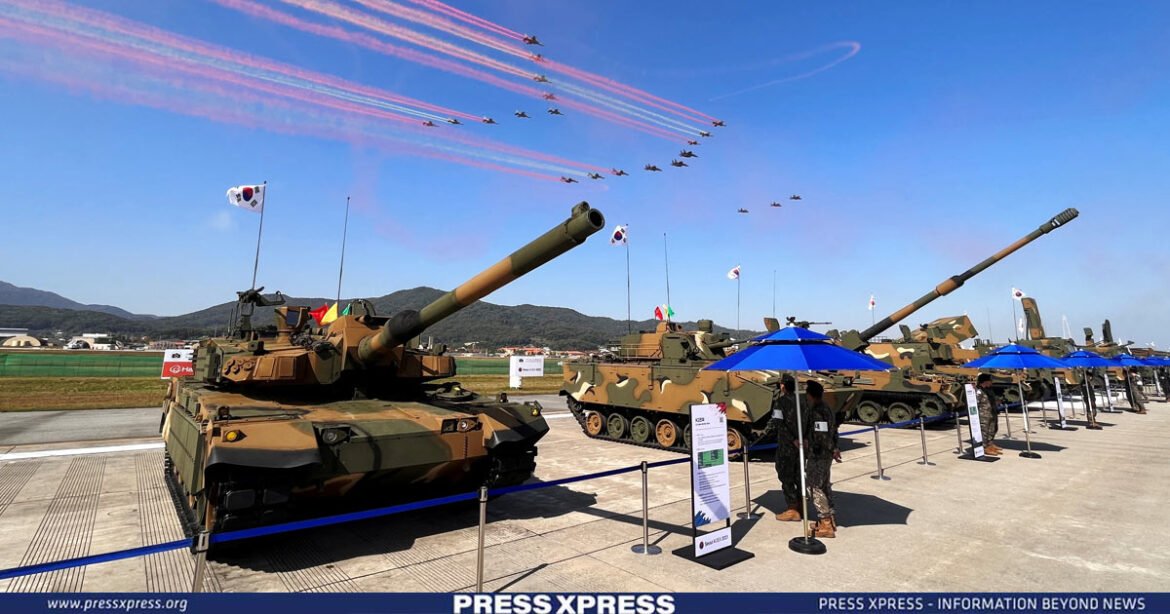South Korea, once a war-torn and impoverished nation, has emerged as a global economic and technological powerhouse in the past six decades. Its remarkable transformation has also been reflected in its defense industry, which has grown from a dependent and underdeveloped sector to a competitive and innovative one.
You Can Also Read: SHEIKH HASINA URGES CLIMATE FUNDS, NOT ARMS
In 2022, South Korea’s defense exports reached a record high of $17.3 billion, a 140% increase from the previous year, making it the world’s ninth-largest arms exporter. How did South Korea achieve this feat, and what are the implications for its foreign policy and security?
Origin of South Korea’s Defense Industry
South Korea’s defense industry was born out of necessity and national security. Following the Korean War (1950-1953), which left the country devastated and divided, South Korea relied heavily on the US for its defense and military assistance.
In 1973, South Korea launched the Heavy and Chemical Industry (HCI) Development Plan, which included the defense industry as one of its key components. The plan aimed to produce indigenous weapons and equipment that could meet the needs of the South Korean military and reduce its dependence on foreign suppliers. The plan also sought to create a domestic market for the defense industry and generate export revenues.
The HCI plan also fostered the development of several defense companies, such as Hyundai Rotem, Hanwha Defense, LIG Nex1, and Korea Aerospace Industries (KAI), which became the main pillars of the South Korean defense industry.
Growth of South Korea’s Defense Exports
South Korea’s defense exports began to take off in the 1990s when the country started to diversify its export markets and products. The first major breakthrough came in 2001 when South Korea signed a contract with Turkey to supply 300 K9 howitzers and transfer the technology for their production. This was followed by other deals with countries such as Egypt, Indonesia, Malaysia, Oman, and the Philippines, mainly for artillery, armored vehicles, and trainer aircraft.
Till then, some of the notable contracts that South Korea secured in the past decade include:

These contracts demonstrate South Korea’s ability to produce and export sophisticated and advanced weapons systems, covering land, sea, and air domains. They also show South Korea’s ability to compete with other major arms suppliers, such as the US, Russia, China, France, and Germany, and to enter new and lucrative markets, such as NATO countries.
South Korea’s Defense Hardware is NATO Standard and Cheap, Attracting European Buyers
One of the reasons why South Korea’s defense exports have been successful is that its weapons and equipment are compatible with NATO standards and requirements. This means that they can interoperate with the systems and platforms of other NATO members and that they can meet the performance and quality criteria of the alliance. This is important for countries that are part of or aspire to join NATO, such as Poland, Romania, and Ukraine, as they seek to modernize and upgrade their military capabilities.
Another reason why South Korea’s defense exports have been attractive is that they are relatively cheap and offer good value for money. Compared to similar products from other suppliers, South Korea’s weapons and equipment are often priced lower, while offering comparable or superior capabilities and features.
European countries that have purchased or expressed interest in South Korea’s defense products include:
- Estonia, which bought 12 K9 howitzers in 2018, worth $46 million.
- Finland, which bought 48 K9 howitzers in 2017, worth $150 million.
- Norway, which bought 24 K9 howitzers in 2019, worth $200 million.
- Romania, which is in talks with South Korea to buy 36 K2 tanks and 8 T-50 trainers, worth $1.6 billion.
- Hungary, which is in talks with South Korea to buy 12 FA-50 fighters, worth $600 million.
- Croatia, which is in talks with South Korea to buy 12 FA-50 fighters, worth $500 million.
Future of South Korea’s Defense Exports
Looking ahead, South Korea has set an ambitious goal to become one of the world’s top four defense exporters by 2027, following the US, Russia, and France. To achieve this goal, South Korea plans to increase its share of the global defense export market from the current 2.1% to 4.5% and to raise its annual defense export revenue from $17.3 billion to $30 billion.
Conclusion
South Korea’s defense export rise is a remarkable achievement that reflects its economic, technological, and military prowess. It is also a strategic asset that enhances its international status, influence, and soft power. However, it also entails responsibilities, challenges, and dilemmas that require careful and prudent management. South Korea needs to pursue its defense export goals with a clear vision, a comprehensive strategy, and a balanced approach while ensuring that its defense industry serves its national interests and values, as well as contributes to global peace and stability.


